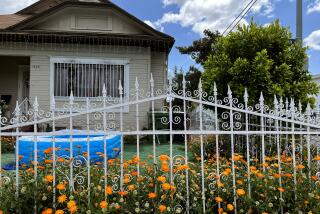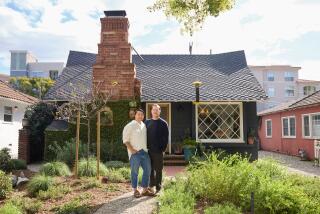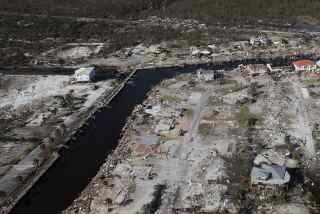STEELING HOME : Metal is making inroads in O.C. housing: Itâs environmentally sound, resistant to quakes and fire and impervious to insects and rot. Itâs also stronger, and now less costly than wood.
What makes the house David Busk is building in Ritz Cove at Monarch Bay unusual isnât its price or location or even the amenities the custom-home builder is adding to his personal residence.
The difference is in the steel framing--something Busk and others in the industry believe is a construction material well within the reach of most people.
Long used in the treeless outback of Australia, in the termite-infested Hawaiian Islands, in office construction and in custom homes around the country, light-gauge steel framing is turning up with increasing frequency across Southern California in moderately priced tract homes. One measure of the growing acceptance of steel framing is that the industry now has its own trade journal: Metal Home Digest, published by Modern Trade Communications in Skokie, Ill. The second issue of the quarterly magazine features articles on steel roofing and the new wave of steel framing in Southern California tract developments and educational material for builders who want to start using metal.
Steel framing even is available these days for the homeowner with a strong do-it-yourself orientation and a desire to try something new. It is being stocked alongside more traditional materials by building material suppliers and at big warehouse retailers. Supplies were limited at the Home Depot in Santa Ana earlier this week, but prices for the equivalent of eight- and 10-foot 2-by-4s in the lightest gauge available were less than half the posted prices for construction-grade wood 2-by-4s.
There are several arguments for steel framing in houses: Itâs stronger and lighter than wood; termites and other insects wonât bother it; it wonât rot; it has more resistance than wood to the tremendous twisting forces of an earthquake or a blasting Santa Ana wind storm; it wonât burn (although if things get hot enough, it can melt), and it is easy to work with.
Until now, however, there has been one overpowering argument against steel as a commonplace building material: It cost more than wood.
That is changing, though, because of an upsurge in metal recycling and diminishing supplies of wood as well as the propensity of timber companies to ship the best grades of wood overseas, where they command premium prices.
Bill Justus, whose Los Angeles-based Silverwood Structures designs and packages steel framing, said he supplied 11 tons of metal for the Busk project.
âAt todayâs prices, the bill is probably 10% to 15% less than if he would have used wood for the framing,â Justus said.
Thatâs good news not only for those building a home but also for those planning to make changes or additions to a home.
Want to add a whole room? Or are you just building a few non-structural walls as you try to maximize the space in the old homestead? Steel works just as well as wood for framing. Maybe better, says architect Scott Martin of Laguna Niguel.
âItâs easy to use, nice and light, so one person can work with it comfortably, and itâs not as messy as wood because you donât have all the sawdust,â Martin said.
âAnd because you screw it together and donât have to drive nails with a hammer when you attach pieces to existing studs and joists, installing new steel framing is a lot less disruptive to existing plaster, glass and drywall.â
Martin, who collaborated with Santa Ana architect Jeff Riggs on the Busk home, is a big fan of metal framing.
âI recently added a prefabricated fireplace at my house and used steel studs for walling it in,â Martin said. âI cut it with a good pair of tin snips and put everything together with an electric screwdriver. It is just really clean and easy. You even use self-tapping screws, so you donât have to pre-drill holes when you put two pieces together. You can use it for just about any remodeling project.â
And with steel there is no danger of importing termites as there is when using untreated lumber for room additions and other framing projects.
Metal framing comes in several styles.
Some builders and framing makers like âstick-for-stickâ systems in which the steel is used in the same manner as wood--2-by-4 studs every 16 inches in the walls, with double 2-by-4s over doorways and window openings. The end product looks exactly like a wood-framed house except that it gleams in the sun before the drywall and exterior covering are added.
But others say stick-for-stick systems are overbuilt; they use too much material and too much labor and cost more than is necessary.
The alternative is an âengineered system,â designed by a structural engineer to take advantage of the strength and other qualities of steel. Using an engineer adds to design costs but can pay for itself by cutting material costs.
âBecause steel is so much stronger than wood, you can use a lot less of it to frame a whole house, or just a room, as long as it is designed by an engineer to be safe,â Martin said.
The most common engineered systems are horizontal girt and superstructure framing, said Justus.
In the first, the steel wall studs are four feet apart, and a horizontal metal channel, or girt, is installed every two feet up the wall. The girt provides bracing and a fastening surface for the interior drywall and the exterior siding or stucco.
A superstructure system uses heavier 2-by-8 framing members every six to eight feet, with light gauge studs filling in every two feet.
The Busk house uses a hybrid--what Justus calls a âvalue engineeredâ system. âIt is built almost like stick-for-stick, but has the studs on 24-inch centers instead of 16 inches, so thereâs very little wasted material.â
*
Avoiding waste is one reason builders and architects are turning to metal. With a designed system, all of the components are made to measure at a mill and then delivered to the site. Workers then assemble the pieces, using self-tapping screws and power screw guns. When cutting is needed--to angle the ends of rafters, for instance--it is done with a special metal-cutting blade on a contractorsâ chop saw or even on a hand-held power saw. For very small jobs using the lighter gauges, tin snips work well. All the shavings and ends trimmed are gathered at the end of the day and sent back to the mill for recycling into more steel framing.
In contrast, builders usually order 20% to 30% more wood than they think theyâll need. The overage--which adds to the cost of each house--protects against warped and split wood and ensures there will be enough to account for odd lengths (they make nine-foot steel studs but they donât make nine-foot wooden studs--the builder buys a 10-foot piece and cuts off a foot).
âThereâs a lot of concern about the environment, and thatâs another good thing about steel,â Martin said. âIt is recyclable. One house like Dave Buskâs saves 250 trees. We are finally getting to the point where we are done wasting wood. Most of this steel is made from crushed cars, so it is something that is in ample supply.â
Brusk cited all of those reasons for opting for metal framing in his own home--the first metal-framed building heâs ever done.
âI like to think Iâm on the cutting edge of the building business,â he said, âand steel is the upcoming technology, so it made sense from that standpoint. And Iâm tired of fighting constantly rising lumber prices. Itâs environmentally sound; I donât have to worry about termites, and it had the highest seismic rating available. There wasnât any waste, and all the pieces that were delivered were straight and true, so my walls will be straight. What more could I ask for?â
*
Busk has shown his house, which still is in the framing stages, to dozens of architects and builders, as well as to a number of people who lost homes in the disastrous Laguna Beach and Topanga Canyon fires of October.
âMy clients are becoming converts because Iâm using the house as a showcase,â he said. âIâve switched two of them from wood to steel in the last month.â
The total construction bill for the 2,600-square-foot stucco home will be about $5,000 more than if it had been framed with wood. But Busk said most of the extra cost came from his decision to cover the entire roof area twice--once with corrugated steel and again with plywood. The steel is for fire safety and structural integrity, he said. The plywood âwill make it easier to fasten down the clay roofing tile without having to use special fasteners.â
Busk also paid a structural engineer to go over the framing design and incurred some costs in the extra time it took his framing contractorâs crew to get comfortable working with metal. But the extras âarenât that much,â he said.
âI figure thatâs $5,000 Iâll never have to spend getting the house fumigated and repairing termite damage, so in the long run the costs are a wash.â
More to Read
Inside the business of entertainment
The Wide Shot brings you news, analysis and insights on everything from streaming wars to production â and what it all means for the future.
You may occasionally receive promotional content from the Los Angeles Times.










